
The Arnolfini Portrait is a 1434 oil painting on oak panel by the Early Netherlandish painter Jan van Eyck. It forms a full-length double portrait, believed to depict the Italian merchant Giovanni di Nicolao Arnolfini and his wife, presumably in their residence at the Flemish city of Bruges.
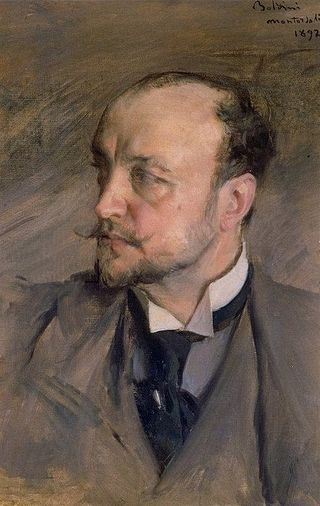
Giovanni Boldini was an Italian genre and portrait painter who lived and worked in Paris for most of his career. According to a 1933 article in Time magazine, he was known as the "Master of Swish" because of his flowing style of painting.
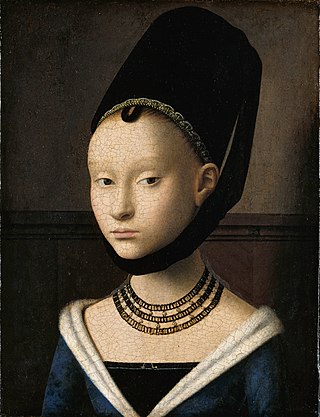
Portrait of a Young Girl is a small oil-on-oak panel painting by the Early Netherlandish painter Petrus Christus. It was completed towards the end of his life, between 1465 and 1470, and is held in the Gemäldegalerie, Berlin. It marks a major stylistic advance in contemporary portraiture; the girl is set in an airy, three-dimensional, realistic setting, and stares out at the viewer with a complicated expression that is reserved, yet intelligent and alert.

Young Girl Reading, or The Reader, is an 18th-century oil painting by Jean-Honoré Fragonard. It depicts an unidentified girl seated in profile, wearing a lemon yellow dress with white ruff collar and cuffs and purple ribbons, and reading from a small book held in her right hand. The painting is in the National Gallery of Art in Washington, DC.

Gertrude Elizabeth, Lady Colin Campbell was an Irish-born journalist, author, playwright, and editor. She was married to Lord Colin Campbell, a brother-in-law of Princess Louise, Queen Victoria's fourth daughter.

Portrait of a Lady is a small oil-on-oak panel painting executed around 1460 by the Netherlandish painter Rogier van der Weyden. The composition is built from the geometric shapes that form the lines of the woman's veil, neckline, face, and arms, and by the fall of the light that illuminates her face and headdress. The vivid contrasts of darkness and light enhance the almost unnatural beauty and Gothic elegance of the model.

The Magdalen Reading is one of three surviving fragments of a large mid-15th-century oil-on-panel altarpiece by the Early Netherlandish painter Rogier van der Weyden. The panel, originally oak, was completed some time between 1435 and 1438 and has been in the National Gallery, London since 1860. It shows a woman with the pale skin, high cheek bones and oval eyelids typical of the idealised portraits of noble women of the period. She is identifiable as the Magdalen from the jar of ointment placed in the foreground, which is her traditional attribute in Christian art. She is presented as completely absorbed in her reading, a model of the contemplative life, repentant and absolved of past sins. In Catholic tradition the Magdalen was conflated with both Mary of Bethany who anointed the feet of Jesus with oil and the unnamed "sinner" of Luke 7:36–50. Iconography of the Magdalen commonly shows her with a book, in a moment of reflection, in tears, or with eyes averted.
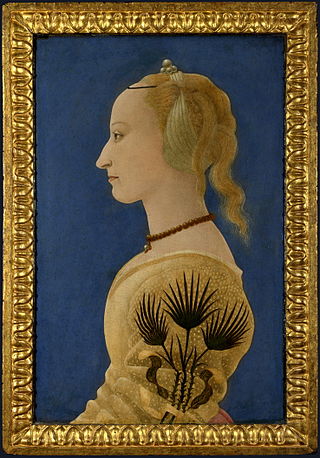
Portrait of a Lady in Yellow was painted by the Florentine artist Alesso Baldovinetti sometime in the second half of the 15th century, most likely c. 1465. For centuries the work was mis-attributed; it was purchased by the National Gallery London in 1866 as a portrait of Countess Palma of Urbino, attributed to Piero della Francesca. In 1911 art historian Roger Fry established that it was by Baldovinetti. However, there is no evidence of the source of the commission, and doubt remains as to the identity of the sitter; the most plausible theory is that she is Francesca degli Stati of Urbino.

Lady Elizabeth Delmé and Her Children (1779) is an oil on canvas portrait by Joshua Reynolds. It was given to the National Gallery of Art in Washington DC in 1937. The NGA describes the work as a "majestic group portrait".
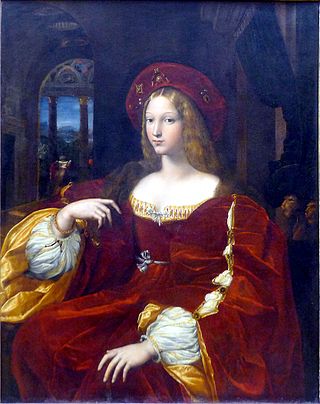
Portrait of Doña Isabel de Requesens y Enríquez de Cardona-Anglesola is an oil painting dated circa 1518 that was formerly believed to depict Giovanna d'Aragona. It has been variously ascribed to Raphael, Giulio Romano, or the school of Raphael; it is now usually taken to have been executed by Giulio Romano based on a sketch by Raphael and then altered by Raphael. The painting is now in the Louvre Museum in Lens.

Franca Florio, born Francesca Paola Jacona della Motta dei baroni di San Giuliano and commonly called Donna Franca, was an Italian noblewoman, socialite and a prominent protagonist of the Belle Époque. Descendant of a Sicilian noble family, she married the entrepreneur Ignazio Florio Jr., member of the wealthy Florio family. She was nicknamed "Queen of Palermo".

Young Girl with a Flower Basket is a 1905 oil on canvas painting by Pablo Picasso from his Rose Period. The painting depicts a Parisian street girl, named "Linda", whose fate is unknown. It was painted at a key phase in Picasso's life, as he made the transition from an impoverished bohemian at the start of 1905 to a successful artist by the end of 1906. The painting is listed as one of the most expensive paintings, after achieving a price of $115 million when it was sold at Christie's on 8 May 2018. It is currently the third highest selling painting by Picasso.

Portrait of Anne, Countess of Chesterfield is a large oil-on-canvas painting by the English portrait and landscape artist Thomas Gainsborough, completed between 1777 and 1778. It shows Anne Stanhope, wife of Philip Stanhope, 5th Earl of Chesterfield, sitting in a blue and while satin dress, sitting in a garden, and is one of the best known of Gainsborough's many portraits of English aristocrats.
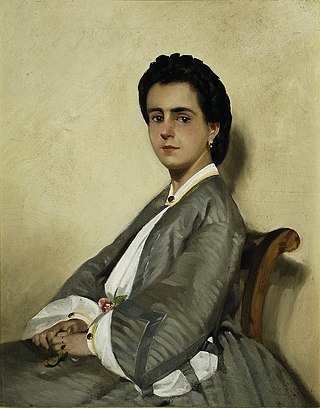
Cousin Argia is an 1861 oil on card painting by Giovanni Fattori, now in the Gallery of Modern Art in Florence. A label on the reverse is inscribed "Gio. Fattori alla sua cugina Argia. Anno 1861", but this may not be in the artist's own hand and no Argia is known in his family.

Conversation at the Café is an oil on panel painting by Italian painter Giovanni Boldini, created c. 1879. It is held in a private collection.

The Portrait of Donna Franca Florio, or Portrait of Mrs. Franca Florio, is an oil on canvas painting by Italian painter Giovanni Boldini. The original work was created in 1901, however it was retouched several times, until the current version, signed and dated in 1924. Since 2017, the painting is in exhibition in the Palazzo Mazzarino, in Palermo.

The Painter Brown and His Family, also known as The Painter John Lewis Brown with His Wife and Daughter, is an oil on canvas painting by the Italian painter Giovanni Boldini, from 1890. It is held at the Museu Calouste Gulbenkian, in Lisbon.
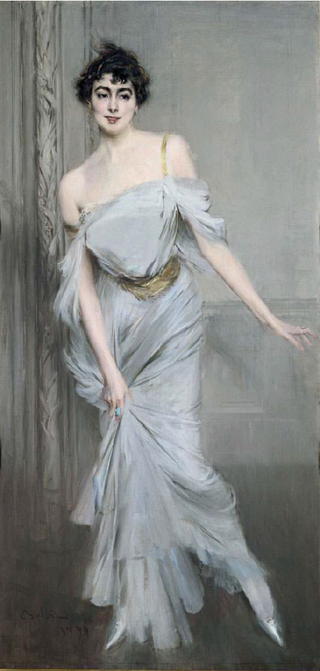
Madame Charles Max is an oil on canvas painting by the Italian painter Giovanni Boldini, from 1896. It is held in the Musée d'Orsay, in Paris.

Portrait of a Lady, also known as The Lady in Red is an oil on canvas painting by Italian painter Giovanni Battista Moroni, from c. 1556–1560. It is believed to depict Countess Lucia Albani Avogadro, a 16th-century Italian poet. It is held in the National Gallery, in London.



















